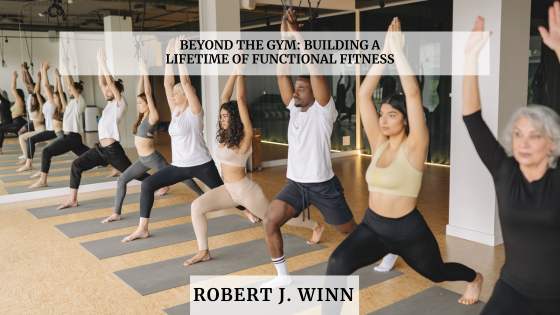
Beyond the Gym: Building a Lifetime of Functional Fitness
When we think about fitness, it’s easy to imagine high-intensity workouts, gym memberships, or the latest fitness trend. But true, long-term fitness isn’t just about sweating through a session — it’s about building a body that supports your life well into your 70s, 80s, and beyond.
Functional fitness is a philosophy that emphasizes movements we use every day — bending, reaching, lifting, walking, or climbing stairs. Unlike isolated exercises that target one muscle group, functional fitness trains your body for real-world activities. It’s not about achieving the “perfect” physique, but about staying agile, mobile, and injury-free as you age.
The Importance of Intentional Movement
Modern life makes it easy to be sedentary. Many of us sit for long periods, and even daily workouts can’t fully counterbalance hours of inactivity. That’s why small, intentional movements matter. Taking the stairs, stretching between meetings, or going for a brisk walk after dinner all contribute to cumulative wellness.
Exercise doesn’t need to be extreme — but it does need to be consistent. A 20-minute bodyweight workout three to four times a week can significantly improve balance, strength, and mobility.
Strength Training: A Non-Negotiable
Muscle mass naturally declines with age, a process called sarcopenia. But strength training, even with light weights or resistance bands, helps slow or even reverse this trend. For adults over 40, two sessions of resistance training a week can enhance bone density, metabolic function, and joint stability.
Fitness as Preventive Medicine
The real win with exercise? Prevention. Regular physical activity lowers the risk of heart disease, diabetes, certain cancers, and cognitive decline. It boosts mood, improves sleep, and helps regulate stress — all without a prescription.
Starting Small, Staying Consistent
If you’re new to fitness or returning after a long break, start small. Choose one or two movements to repeat daily. Track your progress, not just in pounds or reps, but in how your body feels. Can you lift grocery bags more easily? Climb stairs without losing breath?
Fitness isn’t a destination — it’s a lifelong journey. And the goal isn’t perfection, but progress that supports your ability to live fully and independently, every single day.

Why Warming Up and Cooling Down Are Essential for Every Workout
Whether you’re a seasoned athlete or a casual exerciser, incorporating a proper warm-up and cool-down into your workout routine is crucial. These bookends to your training session might seem optional, especially when you’re pressed for time, but they play a vital role in performance, recovery, and long-term health.
The Importance of Warming Up
A warm-up is designed to prepare your body—physically and mentally—for the activity ahead. It gradually increases your heart rate, loosens your joints, and boosts blood flow to your muscles, which in turn raises muscle temperature. This increased circulation helps muscles become more elastic and responsive, reducing the risk of strains and other injuries.
Dynamic stretching, light cardio, and sport-specific movements are excellent warm-up strategies. For example, if you’re preparing for a run, a brisk walk followed by leg swings and gentle lunges can activate the key muscles and joints involved. The psychological aspect is also important: a proper warm-up can help you focus, mentally transition into workout mode, and boost confidence in your performance.
Without an adequate warm-up, your muscles and tendons remain stiff and less responsive, which can hinder performance and increase the likelihood of injury. Skipping it might save five minutes upfront, but it could cost weeks in recovery time later.
The Role of Cooling Down
Equally important is cooling down. After intense activity, your body needs time to transition back to a resting state. A cool-down helps gradually lower your heart rate and breathing, preventing sudden drops in blood pressure and promoting venous return—the flow of blood back to the heart. This reduces the likelihood of dizziness or fainting post-workout.
Light aerobic activity, such as walking or slow cycling, followed by static stretching, forms an effective cool-down routine. This helps flush out lactic acid and other metabolic waste products from the muscles, potentially reducing post-exercise soreness (DOMS—Delayed Onset Muscle Soreness).
Additionally, cooling down can improve flexibility and promote relaxation. It provides a valuable window to reflect on your workout, breathe deeply, and let go of tension, which supports both physical and mental recovery.
The Long-Term Benefits
Incorporating warm-ups and cool-downs consistently offers long-term benefits. You’re more likely to stay injury-free, perform better during workouts, and experience improved recovery times. For older adults and those with cardiovascular conditions, these practices are especially important in safeguarding heart health and joint function.
In conclusion, warming up and cooling down may seem like minor parts of a workout, but their impact is major. They prepare the body, protect it from injury, and promote faster recovery—all while enhancing overall performance. So the next time you think about skipping them, remember: a few extra minutes before and after your session can make a big difference in how you feel today—and in how you perform tomorrow.
About Robert J. Winn
Robert J. Winn is a family physician based in Haddon Township, NJ. For over fifteen years Dr. Winn has worked to provide care to vulnerable populations that face barriers to healthcare access. As a medical professional, Dr. Winn understands how important fitness is to one’s health. On a personal level, he also understands what it’s like to be overweight, so he is able to empathize with patients who struggle to live healthier lives.
Robert J. Winn’s fitness journey started relatively later in life. Although he helped other people become healthy and stay that way, Dr. Winn had fallen victim to a situation that many busy professionals find themselves in. At age 45 he was overweight and didn’t make time for daily exercise. Toward the end of 2014, Dr. Winn realized that something had to change. He had trouble fitting into the clothes he owned, and activities like walking up a flight of stairs exhausted him. Dr. Winn made the decision to turn his health around by devoting himself to fitness.
One of the most important aspects of being a physician is making sure that patients are taking the necessary steps to remain healthy. However, Dr. Winn was not following his own recommendations. In order to remedy this situation, he joined Unite Fitness, a local fitness studio. The Unite Fitness philosophy of “Heart, Muscle, Mind” resonated with Dr. Winn. With the help of Coach Gavin, the founder of the studio, Dr. Winn was able to shed 50 pounds over the course of six months.
Although Robert J. Winn started his fitness journey by attending a fitness studio and receiving instruction from the staff, he realizes that many people, including the majority of his patients, may not have the resources to purchase a membership or home fitness equipment. It’s important to remember, though, that getting in shape does not have to cost an exorbitant amount of money. In fact, you don’t have to join a gym or purchase anything to get started. Dr. Robert J. Winn recommends that patients begin by walking 30 minutes each day. Also, on the internet, you can find numerous free resources like exercise tips and guides that you can use to workout at home in your living room.
One way that Dr. Winn stayed motivated in the beginning of his fitness journey was by sharing updates on social media. His friends and family saw his progress and encouraged him along the way. Plus, patients were able to witness the transformation take place firsthand. As a result, many patients were inspired to get in shape themselves. Sharing his fitness journey on social media also encouraged Dr. Winn to work harder to lose weight because he didn’t want to let his patients down. He wanted to show them that it was possible for anyone to get in shape and become healthier as long as they are dedicated and work hard.
Being overweight leads to many health issues such as depression, high cholesterol, and diabetes just to name a few. Exercising on a daily basis can prevent or eliminate these types of difficulties. Dr. Robert J. Winn uses his personal fitness journey as an example that patients can relate to. Today he feels stronger, healthier, and happier as a result of his active lifestyle and healthy diet. He continues to encourage his patients to take small fitness steps so that they can live life to the fullest with fewer health issues holding them back.
To help keep others healthy, Robert J Winn just opened Real Wellness, LLC, a private family medicine practice that’s located in Haddon Township, New Jersey. Real Wellness is not a typical doctor’s office. Winn’s practice treats the patient, instead of just whatever issue they’re having. At the patient-centered practice, all appointments last for at least 30 minutes in order for Dr. Winn to get to know each patient and their background so he can provide the best possible care. Many practices are too focused on how many patients they get that they don’t provide quality care. Robert J Winn focuses solely on the quality of care he gives every patient, which is what makes him so successful as a physician.
